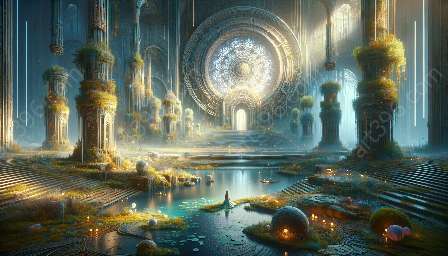Concept art is a vital component of the design process in various creative industries, including video games, movies, and animation. One of the essential elements in creating compelling concept art is the understanding and manipulation of light and shadow. However, the approach to handling light and shadow can significantly differ between traditional and digital concept art.
Traditional Concept Art
Historically, traditional concept art involved physical mediums such as pencils, charcoal, and paint on canvas or paper. Artists relied on techniques such as shading and cross-hatching to convey the interplay of light and shadow within their artworks. The texture and tactile nature of traditional materials allowed for a more hands-on approach to creating depth and form using light and shadow.
In traditional concept art, the handling of light and shadow is a manual process that requires a deep understanding of the principles of light, including value, contrast, and form. Artists often apply various traditional rendering techniques to achieve the desired light and shadow effects, emphasizing the physicality of the medium and the direct interaction with the artwork.
Differences in Handling Light and Shadow
One of the key differences in traditional concept art is the direct manipulation of physical materials to create light and shadow. Artists need to master techniques such as smudging, blending, and layering to achieve rich and nuanced effects. The use of different grades of pencils or brushes allows for precise control over the application of light and shadow, resulting in a tangible and organic quality in the artwork.
Furthermore, traditional concept art often involves the use of traditional lighting setups and physical props to study and capture the interplay of light and shadow from real-life observations. Artists may rely on traditional methods of studying light and shadow, such as drawing from life or working with live models, to develop a deeper understanding of how light behaves in various environments.
Digital Concept Art
In contrast, digital concept art leverages technology and software tools to create art on digital platforms such as graphic tablets and computer software. The digital medium offers unique advantages in handling light and shadow, providing artists with a range of digital brushes, layers, and lighting effects to simulate realistic lighting scenarios.
Artists working in the digital realm can utilize digital painting software to mimic traditional techniques or explore innovative methods of manipulating light and shadow. The use of layers in digital art allows for non-destructive editing, enabling artists to experiment with different lighting setups and shadow placements without altering the original artwork.
Differences in Handling Light and Shadow
Digital concept art offers an array of digital tools and features that streamline the process of handling light and shadow. Artists can manipulate light sources, adjust shadows, and create complex lighting effects with precision and flexibility. Digital art software provides dynamic lighting controls that allow artists to simulate natural and artificial lighting conditions, enhancing the visual impact of the artwork.
Additionally, the digital medium enables artists to easily replicate and modify light and shadow elements, fostering a more iterative and explorative approach to lighting design. With the ability to instantly undo and redo changes, digital artists have the freedom to experiment with different lighting scenarios and adjust light and shadow elements with ease.
Impact on Understanding Light and Shadow in Concept Art
Understanding how light and shadow are handled in traditional vs. digital concept art is crucial for concept artists looking to broaden their skills and adapt to evolving technologies. Traditional techniques offer a tangible and tactile approach to creating art, emphasizing the physicality of materials and the mastery of traditional rendering methods.
On the other hand, digital concept art opens up new horizons for exploring light and shadow, providing artists with a versatile and efficient platform to experiment with complex lighting scenarios and create immersive visual experiences. The seamless integration of digital tools offers unprecedented opportunities for artists to push the boundaries of lighting design and storytelling within their concept art.
Concept Art and the World of Creativity
As concept art continues to play a pivotal role in shaping the worlds of video games, movies, and animation, the mastery of handling light and shadow remains a timeless and essential skill for concept artists. Whether working in traditional or digital mediums, the ability to skillfully manipulate light and shadow contributes to the visual impact and storytelling potential of concept art, captivating audiences and inspiring the creation of captivating worlds.

